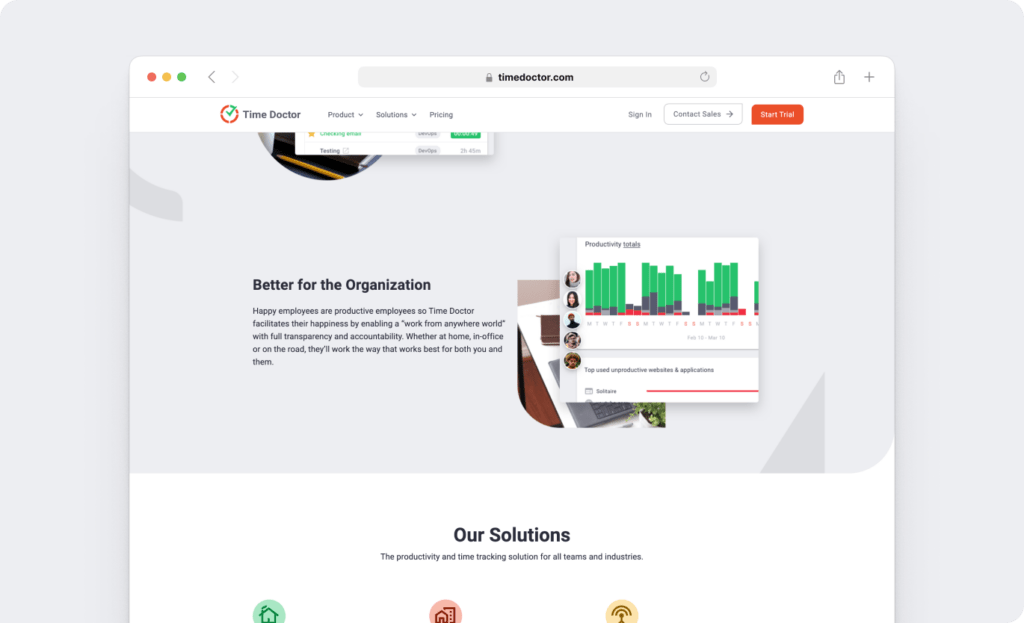Since the Coronavirus pandemic, new work arrangements like the hybrid work model have become increasingly popular.
It ushered in increased productivity and flexibility – a win-win for both employers and employees.
As a result, most companies, including giant enterprises like Microsoft, continue with these flexible work models.
If you’re looking to implement a hybrid work model and want to know if the benefits outweigh the drawbacks, you’ve come to the right place.
In this article, we’ll cover 10 benefits of hybrid work model and smart tips to consider when implementing flexible work models.
Table of Contents
- 10 key benefits of hybrid work model for your business
- 7 smart tips to make hybrid work model a success for your business
Let’s jump in!
10 key benefits of hybrid work model for your business
The hybrid workplace model is a location-flexible work arrangement that allows for a blend of office work and remote work.
Read this informative post to learn more about hybrid offices.
This working model helps improve the overall employee experience and offers several benefits for employers.
Curious to know more about them?
Here’s a closer look at the 10 benefits of a hybrid workforce:

1. Reduces operating costs
Hybrid workplaces can help lower operating costs for businesses, especially logistics and infrastructure-related expenses.
Here’s how:
- Real estate: With remote workers, you require less physical office space, saving you money on rent and utilities like office supplies.
- Food: The cost of providing employees with meals and refreshments can also decrease with a remote workforce.
- Maintenance services: Less in-office employees mean you won’t have to spend as much on cleaning and other maintenance services.
2. Increases employee productivity
Many employees feel that their working environment has an impact on their productivity.
A Stanford study found that remote workers are 13% more productive than those working in traditional office environments.
That’s why a change of workspace can lead to increased productivity within a hybrid team, especially on solo projects.
Traditional office spaces don’t allow much room for personalization, and they may lack the required sunlight, air, or space.
So, allowing employees to work from a spot of their choice can eliminate distractions found in a physical office space.
3. Provides employees more opportunities to upskill
A whopping 91% of employers and 81% of employees believe upskilling is pivotal to their productivity and overall performance.
Employees working part of their workweek from the office can use the remainder of their time honing their skills at home.
It may lead to better job performance, higher self-esteem, and faster growth within the business.
So employers shouldn’t overlook this vital benefit when assessing the pros and cons of hybrid workplaces and remote working.
4. Access to a wider talent pool
A hybrid workplace takes an employer’s talent search from local to international.
The hybrid model allows employers to tap into a vast talent pool of employees globally, diversifying the workforce.
Additionally, bringing people together from different cultures and backgrounds offers fresh perspectives and greater potential to innovate within a remote team.
5. Improves employee work life balance
According to a Linkedin study, 86% of professionals believe that hybrid work is essential for a better work life balance. Around 48% of respondents attributed this to spending equal time on personal and professional goals.
A hybrid worker gets adequate time for personal commitments as a hybrid workplace allows for a balance of remote and office work.
For example, they can plan their lunch break to fetch kids after school, squeeze in their daily jog, or care for an elderly family member.
With this sense of self-determination, employees can enjoy a better work life balance and increased employee satisfaction.
6. Enhances collaboration
Thanks to technological advancements, employees no longer have to gather in the same meeting room to work collaboratively.
The hybrid work model prompts companies to adopt these efficient workplace management software to keep their remote workforce connected.
By employing effective technology, such as Zoom and Slack, employees can communicate and collaborate via video conferencing from anywhere in the world.
Moreover, collaboration goes hand-in-hand with employers’ ability to recruit global talent, as it’s no longer limited to physical office work.
This allows fresh perspectives to come together in a way that wasn’t possible before, opening doors to enhanced collaboration.
7. Less commuting time
Long commutes cost valuable time and money, especially with rising gas prices.
As per the U.S. Census Bureau, American professionals spend 55 minutes driving to and from work daily. This adds to nearly 40 hours a month.
Hybrid work can reduce commuting time, allowing employees to use that time productively.
For example, employees can use the time saved for personal goals like working out or taking up an art class.
A Cisco Global Hybrid Work Study shows that 52.9% of employees have increased job satisfaction due to reduced commuting time.
8. Provides more flexibility to employees
With the traditional working model, employees would travel to the office full time and work an eight-hour shift before heading home.
In contrast, the hybrid work model offers both office and remote workers better flexibility and freedom.
For example, a hybrid worker who may benefit from taking longer lunch breaks and working into the evening hours can do so.
Similarly, an employee who prefers working in silence can get more work done from a favorable spot instead of a noisy office.
This flexibility allows employees to make the most of their work hours while boosting employee satisfaction.
9. Improved employer-employee trust
Trust is an essential building block for fruitful and long-term professional partnerships.
Hybrid workplaces aid in strengthening the mutual trust between employees and the company.
How?
It lets employees gain their employer’s trust by demonstrating they’re just as productive, if not more when working remotely.
Similarly, when employers give their staff members more autonomy, the members feel empowered, improving job satisfaction and retention.
10. Promotes mental wellbeing
A key factor that employers shouldn’t overlook is employee wellness.
As per a report from Achievers, 28% of employees said increased support for their wellbeing would make them feel more valued in the workplace.
The hybrid work model allows employees to spend more time with loved ones, more time focusing on their health, and the opportunity to indulge in self-care.
Employees may perform better in their roles when they are encouraged to take care of their mental health, leading to increased productivity for a business.
Next, let’s explore ways to transition to a hybrid work model smoothly and effectively.

7 smart tips to make hybrid work model a success for your business
Now that we’ve covered the benefits of hybrid working let’s go through some best practices for implementing a hybrid work model more effectively within your organization.
1. Choose the perfect hybrid model for your needs
With the emergence of different types of hybrid working models, it is essential to see which model best suits your industry. Here are a few examples of these models:
- At-will: Employees decide when to come into the office.
- Split-week: The company assigns specific days for on-site and remote employees.
- Week-by-week: Employers can assign dedicated weeks for in-office and remote work for employee groups.
This is where your Human Resource (HR) department plays a crucial role. An HR leader can take charge of implementing a hybrid model that suits the scope of each employee’s position.
Once you have chosen a hybrid model, you must communicate expectations about working schedules and the ideal hybrid workspace with your team.
2. Devise a communication plan
A major downside of hybrid working is that your internal communication may take a hit.
Office workers may have more opportunities to make meaningful contributions due to in-person communication. In contrast, remote workers may feel more like observers.
As a result, employers must have an effective communication strategy in hybrid workplaces.
Here are some practical tips to consider when devising a good communication plan:
- Have a clear and concise communication policy in place.
- Empower your team with communication tools like Slack, Zoom, etc.
- Choose asynchronous communication to ensure constant updates.
- Rely on virtual communication channels for communication by both in-office and remote employees to ensure everyone stays on the same page.
3. Track employee productivity
To ensure smooth operations, employers must effectively track employee productivity, especially for a remote workforce.
With a hybrid work model, employees may pass off their unproductive hours as work which affects the company’s overall output.
So how can employers monitor their team’s productivity accurately?
With the help of technology solutions, tracking your employees’ work activities and the progress of all your projects is simple.
For example, Time Doctor is an advanced tool that can help you monitor employees’ productivity regardless of where they are.
What’s Time Doctor?

Time Doctor is a powerful productivity management tool that can help you improve your team’s efficiency. It’s trusted by growing companies like Thrive Market, as well as large enterprises like Ericsson.
Using Time Doctor’s powerful features, employers can ensure that both in-office and remote employees stay on top of their tasks. The tool can also help them spot any overworking issues at the earliest.
Let’s take a peek at some of the key features of the Time Doctor app:
- Easy to use time tracking modes (manual and automatic) for recording time spent on a specific task or project.
- Comprehensive productivity reports.
- Idle time pop-ups ensure employees stay focused on their tasks.
- Detailed Attendance reports.
- Payroll feature with automated timesheets for easy payment processing.
- The latest security features to keep your data secure.
4. Ensure effective leadership
Many employees look toward higher management for inspiration and guidance.
And more so when working remotely.
Adjusting to the change from in-office to remote work can be daunting for some.
Effective leadership can help combat this, as employees feel heard and valued by their employers.
This can be done by:
- Having an open-door policy for employees regarding adjusting to remote work.
- Celebrating your employees on their birthdays and milestone occasions.
- Addressing growth opportunities and rewarding hard workers.
- Mediating and resolving workplace issues and concerns to ensure employees can perform their roles with little interference from grievances.
If the top management isn’t leading their team in a manner that fosters transparency, collaboration, and communication, it may lead to a team member becoming demotivated.
Effective leadership ensures no biases in the workplace and strives to provide a positive employee experience.
5. Schedule regular check-ins with employees
Employers must monitor employees’ morale, especially when working remotely.
Employers should schedule regular check-ins, encourage meaningful conversations and ask for employee feedback.
You can do this through a host of video conferencing tools, such as:
This easy employee engagement practice can improve job satisfaction while lowering the risk of burnout.
6. Monitor cyber-security risks
Cyber-security risks present a unique challenge for businesses implementing a hybrid work model.
In a remote working space, threats like phishing have become more common. Not having a dedicated IT team may leave your company data vulnerable.
Educating employees on how to protect themselves from potential cyber-security risks is essential. Here are some security tips to keep in mind when working remotely:
- Use a secure anti-virus software.
- Use a secure VPN.
- Employ a centralized storage solution to ensure sensitive data is fully controlled and protected by the business.
- Make sure passwords are strong and secure by applying two-factor authentication.
7. Build a positive company culture
Company culture is essential to the success of any business. However, ensuring a sound culture in a distributed workforce may be tricky.
Before implementing a hybrid work model, it may be worth revisiting working policies to ensure both on-site and remote employees feel empowered.
Here are some practical tips for developing a positive company culture within a hybrid workforce:
- Foster meaningful connections among employees.
- Prioritize in-person events, such as team-building activities.
- Encourage a healthy work life balance.
With a positive company culture, employers can foster an environment where employees feel valued, increasing their willingness to make meaningful contributions.
Check out some other tips and tool to improve your Remote Work Culture.
In summary
There is no denying that hybrid working models are the future of work.
Like any work model, a hybrid work environment has significant benefits when implemented correctly.
For employers, hybrid working models minimize operating costs, allow access to a wider talent pool and improve employer-employee trust.
Employees experience greater flexibility, better work life balance and increased productivity as a result of these models.
You can build a thriving hybrid workspace by carefully considering its benefits, choosing the correct tools, and ensuring clear and concise communication channels.

Liam Martin is a serial entrepreneur, co-founder of Time Doctor, Staff.com, and the Running Remote Conference, and author of the Wall Street Journal bestseller, “Running Remote.” He advocates for remote work and helps businesses optimize their remote teams.


